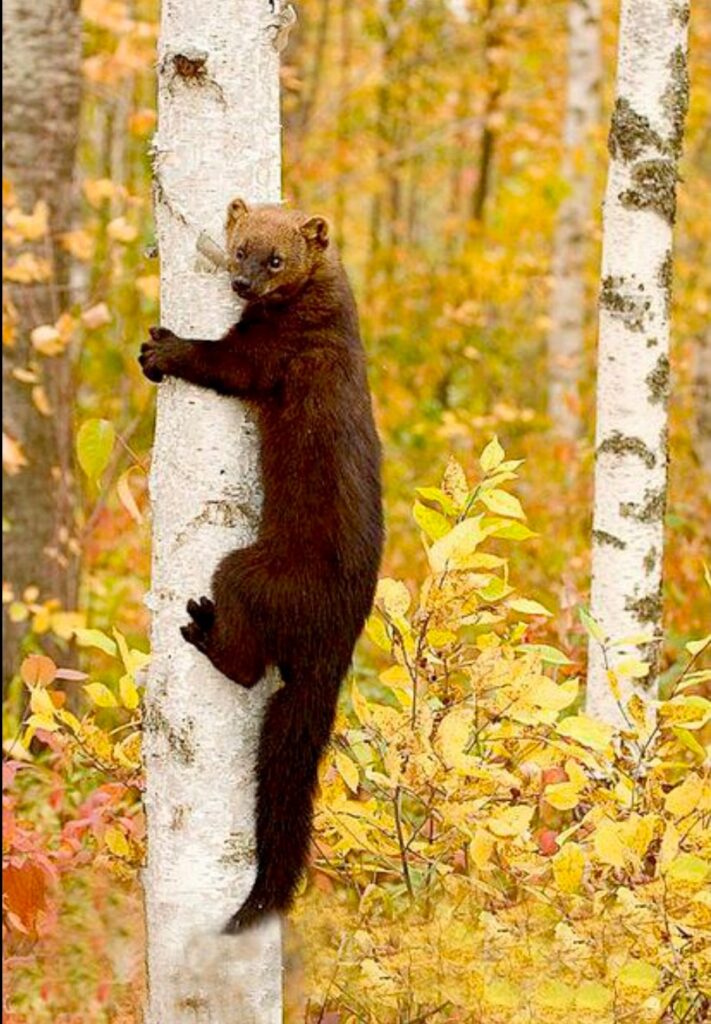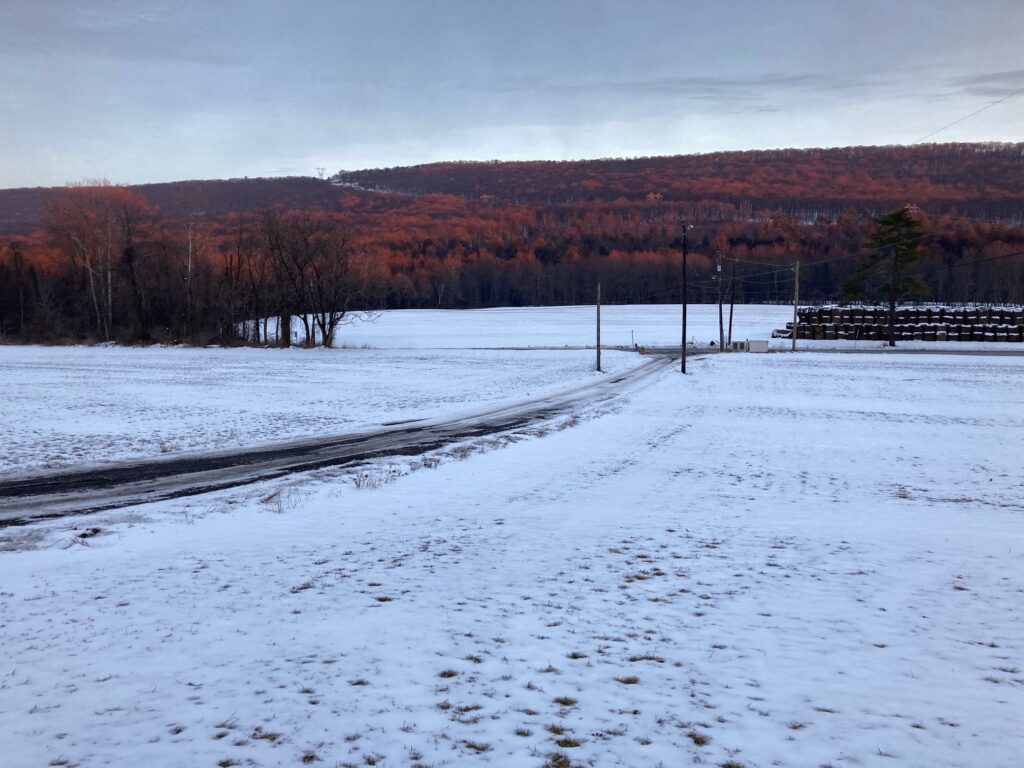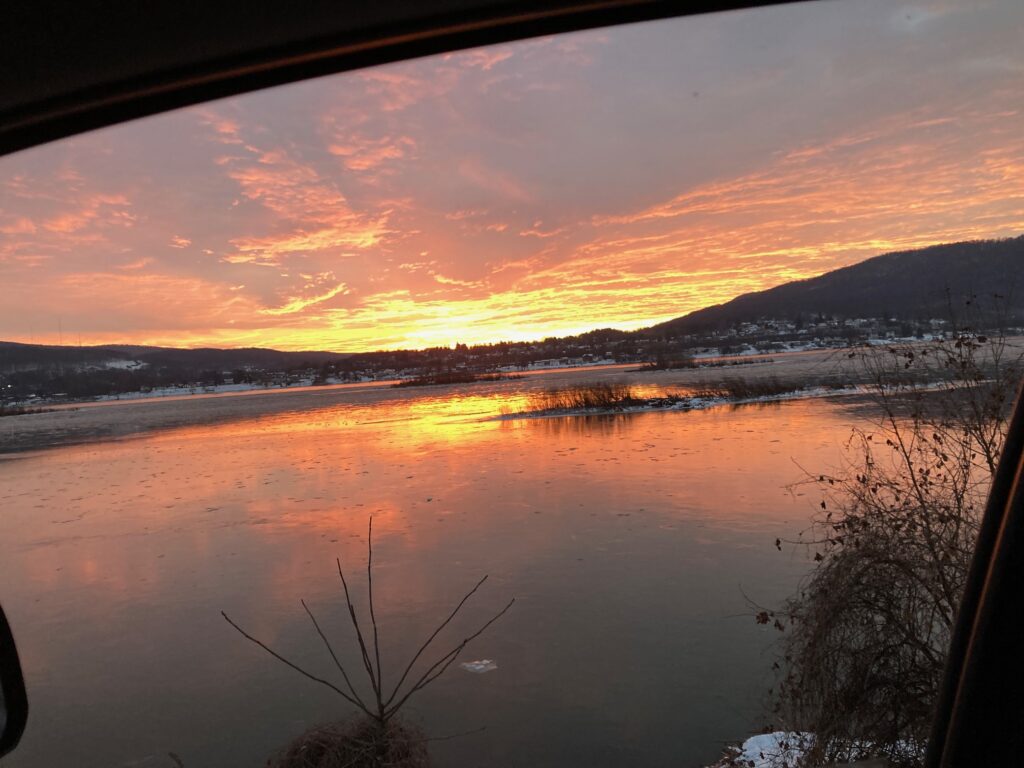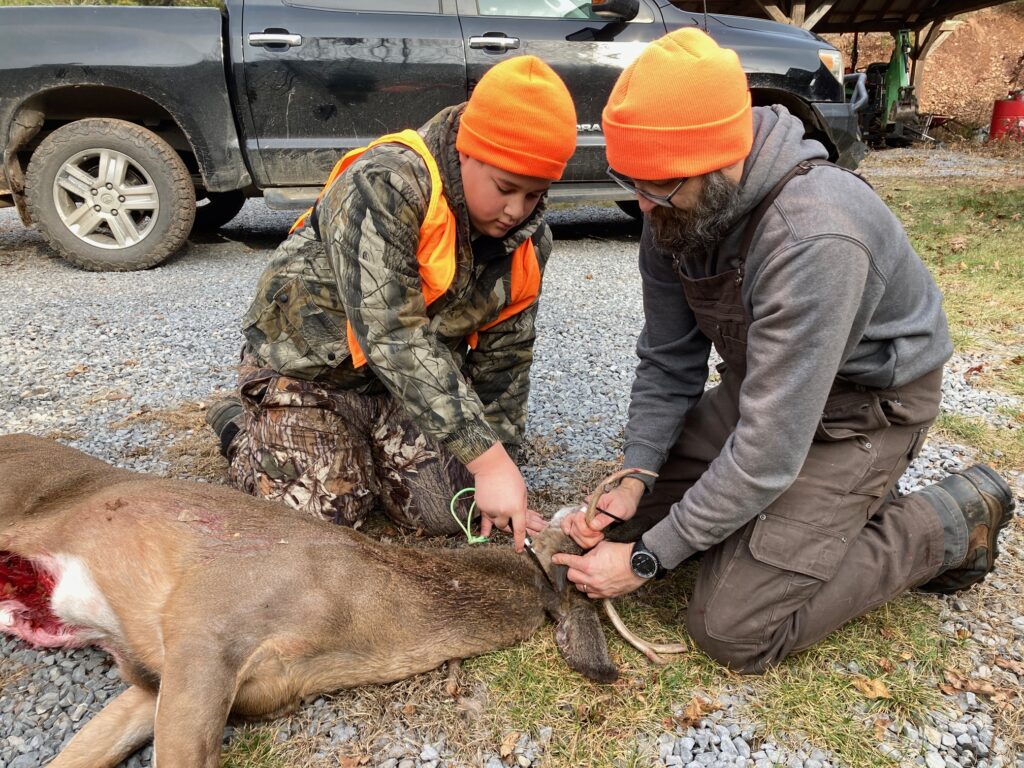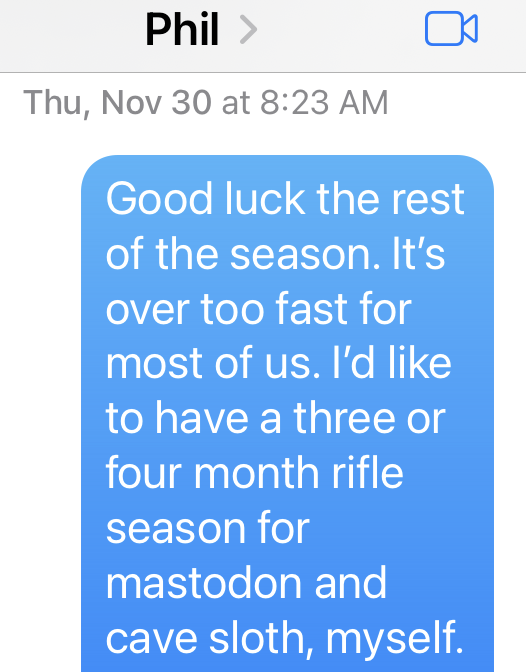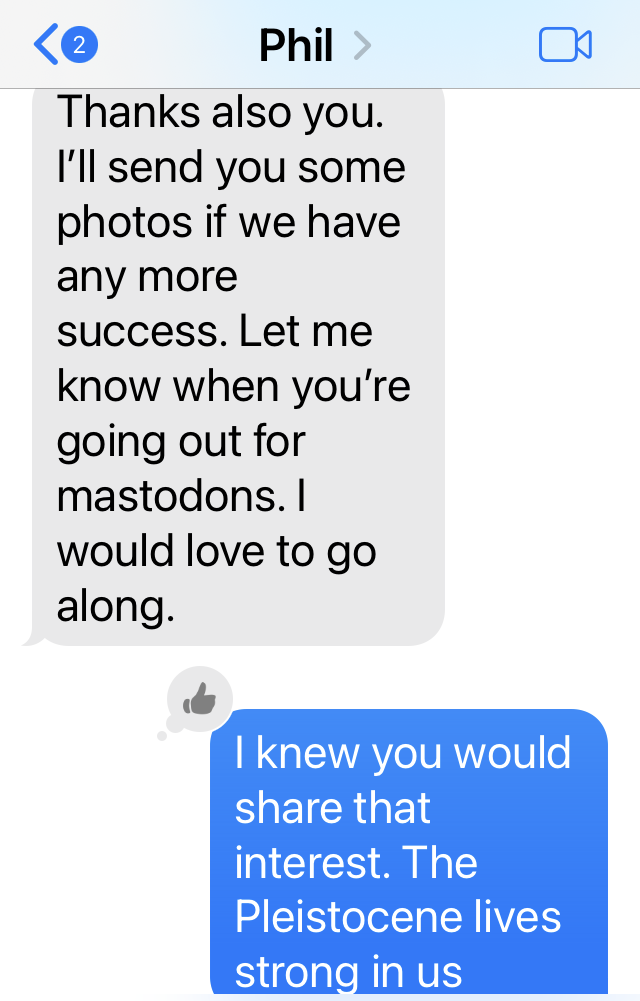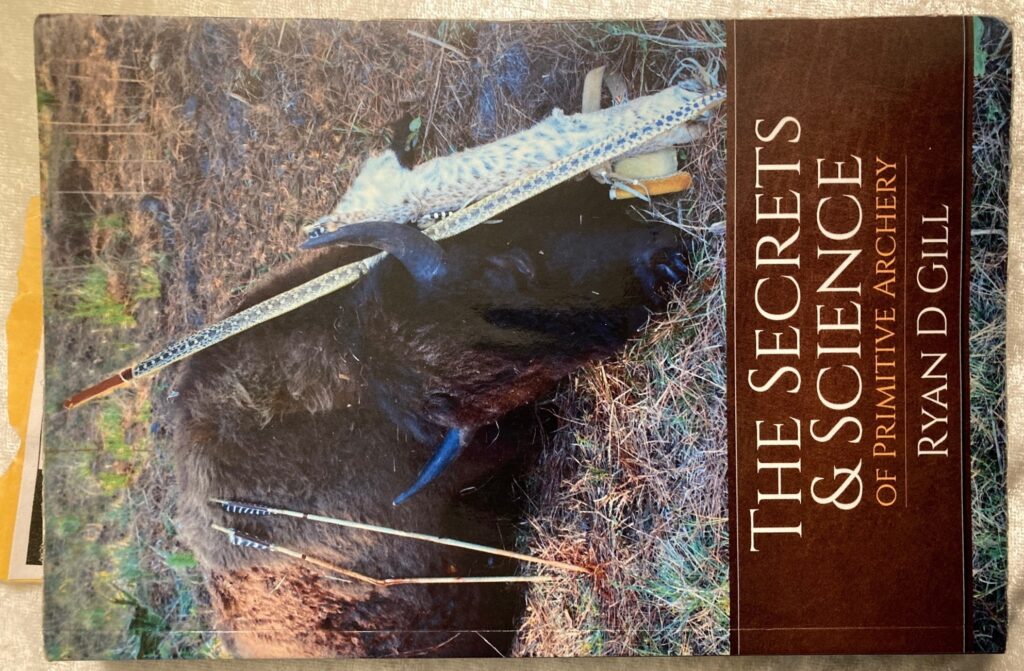Posts Tagged → hunt
PA Game Commission changing leadership
Kind of a wildlife management wild ride here in the Keystone State, though it is tough to tell if anyone really noticed or if anyone really cared. I care. People who care about animals should care.
In just a few weeks the Pennsylvania Game Commission has gone from from a very traditional conservation leadership style and background to a new style and background we have not seen in over a hundred years. I think this is a good thing, though I am sad about how it happened.
Recall that several months ago, attorney Steve Smith was promoted from director of the PGC’s Bureau of Information to deputy director of the agency, second in command to executive director Bryan Burhans. A good choice, as Smith is the very image of the dutiful, honest, earnest, hard working, straight shooting, unemotional, careful, procedurally diligent government employee. While PGC is a long way from the colorful Wild West frontier culture it once had, it still has a shadow of a bunker mentality and insular culture that do not serve the agency, its employees, or the public, and Steve is not representative of that.
Where Bryan Burhans had worked at the American Chestnut Foundation and other iconic conservation and wildlife management groups, with direct personal contacts in the nonprofit and foundation world, Steve Smith is an attorney who just happens to hunt, fish, and trap, and of course share the wildlife and habitat conservation ethos that animates hunters, trappers, and “fisherpeople” everywhere.
A devoted family man, Smith worked in private legal practice before joining PGC’s legal staff about 16 years ago. Where Burhans carried the mail for nonprofit advocacy groups both out of PGC and in it, which is the traditional model for wildlife management agency leaders across America, Smith has been long focused on public agency nuts and bolts. Dotting I’s and crossing T’s in the shadow of big speeches and public policy debates.
There is a gigantic world of difference between these two men, Bryan and Steve; their backgrounds, personalities, and outlooks could not be more different. Again, we are going from strength to strength with the change.
Bryan Burhans gets tons and tons of credit for gently, sometimes assertively molding the PGC into a more publicly accessible, publicly responsive public agency. Unlike most of his predecessors, Bryan was not a former Game Warden. And so from his own get-go seven years ago he was less insular, less committed to the law enforcement view of all things wildlife.
Yes, if you read some news reports about Bryan’s departure a couple weeks ago, you will then read about some state lawmakers griping that the agency is still not as accessible or responsive as the PA Fish & Boat Commission. I am sure that is true, and for good reasons. But compared to where the once insular and bunker-mentality PGC was, say, ten years ago, or especially twenty-five years ago, it is light years better now. Much improved. And, gasp if you must, the PGC actually now employs women in senior positions. This may be not big news to most people, but it is a fact that wildlife agencies are notoriously hide-bound and ultra traditional, the PGC having rung the bell in this regard for a long time. Celebrated wildlife biologists like Mary Jo Casalena may work for PGC, but it is as rare as hen turkey teeth that they also then get into senior management positions.
What is interesting about Steve Smith’s elevation to executive director upon Bryan’s departure is that we are actually seeing Pennsylvania wildlife management style return back to the days of Kolbfus and Pinchot – Americans without the supposedly key wildlife science “credentials” who simply care very much about wildlife, environmental quality, and habitat, and who have the intellectual capacity and personal management skills to implement the necessary policies.
PGC’s executive director is going from an outspoken advocate (albeit occasionally for things unrelated to wildlife management) to a quiet, humble, careful, almost reticent thinker. I am lamenting Bryan’s good-bye, because he did an outsanding job, and I am also really welcoming Steve’s hello. I believe that the many passionate watchers and stakeholders of PGC will be happy with Steve’s leadership there. Of course, those hunters who demand more deer than the landscape or society can sustain will never be satisfied, and I feel sorry for those people.
Update: Long and interesting interview with new ED Steve Smith is here.
talkin turkey
Spring Turkey Season is almost upon us here in Pennsylvania, and around the country. A great deal of the wild turkey breeding season is already behind us, and the significant challenge of calling in a “lovesick tom” at the tail end of the breeding period is now laid before several hundred thousand dedicated and novice turkey hunters alike, here in PA.
Couple of reminders, and one big observation:
- Please do not drive up and down country roads making hen calls out the window of your vehicle, waiting to hear a gobble in response. While it may bring some hunters a premature auditory orgasm to hear the lusty gobbler responses, all this activity really does is educate turkeys about fake calls by fake hen turkeys. And when tom turkeys get unnecessarily educated by guys peeing in their pants with excitement, said toms become a zillion times harder to hunt and bag. It takes the fun out of an already difficult hunt. Don’t do it. Please.
- Clearly identify your male turkey’s red or white head before pulling the trigger on its neck. If all turkey hunters only pulled the trigger when they had absolutely positively identified their target, there would be no heartbreaking hunting accidents during spring turkey season. And when you read the facts surrounding those hunting accidents or negligent shootings, you realize that some people are about to pee in their pants with excitement and so they shoot a human being “in mistake” of a turkey. By only putting our trigger finger on the shotgun trigger when the gobbler’s head is both clearly visible and in range, we bypass a lot of dangerous excitement.
Finally, in a certain nook up north, I have been enjoying the sounds once again of spring gobblers sounding off for probably six weeks now. Few have been the wild turkey gobbles there over the past ten to twelve years, an absence always correlated with the physical evidence of a resident fisher. In other words, fishers have eaten the hell out of our wild turkeys, and only after someone traps the local fisher do the turkey populations begin to rebound. This fact has been driven home for me year after year across southcentral, central, and northcentral PA; fishers have been real hard on our wild turkeys.
Not to say that fishers don’t have a place in Penn’s Woods, they do, of course. But the policy implications of widespread fishers should have been better considered before the giddiness of super-predator 100% ecosystem saturation overtook wildlife managers in the late 1990s and early 2000s. And now Pennsylvania is contemplating releasing pine martens into Penn’s Woods…..knowing already that they eat the hell out of grouse, and that PA’s grouse are in very bad shape.
I don’t mind having a decent population of fishers and pine martens up north in the Big Woods, where they will have the least amount of impact on other wildlife across the entire state. What I do object to is sacrificing the enormous wild turkey conservation success story on the altar of “more predators are better than few” mindset of some wildlife managers. Sometimes, we just have to accept that we can’t wind the clock back to the year 1650, or even 1750, because the few successes we have managed to rack up, like wild turkeys brought back from extinction, is as good as it can get.
Sometimes, good is good enough, and the rest we just need to leave well enough alone.
Reviewing the Marlin 1895 SBL
I have had some Marlin rifles, and what American deer, bear, or small game hunter doesn’t have one or two along the way in a life in the woods. But I never got so excited about one of them that I needed to join an online forum to discuss them and compare notes on handloads (handloads are non-commercial ammunition loaded by hand by the end-user, on a personally owned loading press, allowing the shooter to tailor ammunition to exacting tolerances and specific uses). This changed with the purchase of a new Ruger-made Marlin 1895 SBL, which I am really liking (after sending it back for much needed warranty work immediately after taking possession of it brand new in the box from the factory – ahem).
Overview
The new Ruger-made Marlin 1895 SBL (https://www.americanrifleman.org/content/2023-rifle-of-the-year-marlin-1895-sbl/) is a rugged, well designed firearm that I bought for two reasons and for two uses: It is fast shooting and unusually hard hitting within 50-60 yards for a sporting rifle, and I cannot think of a better rifle to hunt with on our bear drives here in PA and on bear hunts in Alaska.
After several months of ownership, here are my experiences with this gun.
Despite purchasing it brand new from the factory, I returned it to Marlin one day after picking it up from the gunshop, because the lever screw backed out, the action kept binding up, it was difficult to cycle the lever, had lots of sharp metal edges, and proud wood around the tang. This gun should have never been allowed out of the factory in the first place, and yet the buyer demand is so high that there must be pressure on the factory to just sling them out the door. According to reports made by other new owners, my experience is not unique. Ruger Marlin is going to kill their golden goose if they keep up this sloppy behavior. The gun is being sold on its presumed high quality.
The “Improved, slimmer” Forearm
While Marlin touts that the new, improved 1895 SBL forearm is slimmer than the old one, it is still too fat. This forearm is hardly easy to handle, and is not slim by any definition. It can easily use another 1/8” shaved off each side, or more, and tapered, like a shotgun forearm. That is, if you mean what you say about the forearm being easier to handle, dear Marlin.
Floppy Trigger Syndrome
The SBL’s factory trigger is pretty good, though it could be better. It is almost crisp, with a very defined and short step of creepy travel, and no stacking, but is a bit heavier than I and other users would like. It works well as a hunting trigger, which is all it really has to do anyhow. I don’t think this trigger was designed by a liability-minded lawyer. Other reviewers have reported that their 1895 SBL triggers were coming in between 5.5 to 8.5 pounds pull weight, and I am just guessing that this particular gun’s trigger is around 5.5 pounds. My preference would be in the 2.5-4.0 pound pull weight range, but I do not believe this factory trigger is adjustable. So “it is what it is,” as that tired old cliché goes, though there are superior aftermarket triggers available (https://www.wildwestguns.com/product/trigger-happy-kit/). One thing I do not like about the factory trigger is that it flops around and can make a tiny metallic sound. It would be preferable that it be stationary, locked in place, and not make noise. Because it’s on a hunting gun, and hunters require stealth. Nonetheless, the factory trigger works well as-is, and it certainly could be a lot worse.
One Rugged Beast
The SBL is one well made and tightly built rugged beast, and I think this is one of the main reasons for its popularity. Stainless steel and high tech laminate wood on anything, especially a firearm, mean it is made for southeast Alaska, at least, or anywhere else that is physically challenging and frequently wet and/or loaded with salt air. This is a rugged gun that should take all the wet and salty environment that could ever be encountered under normal hunting or camping conditions. The stainless steel does result in a shiny, reflective presence, however, and maybe too shiny for a hunting gun. Someone out there is going to bead blast their SBL for good reason, and thereby start a trend.
OK, I Guess Modern Hunting Guns are High Tech
Because I am a devoted black powder shooter and hunter, and because the year 1895 was the pinnacle of firearm development for people addicted to antiques and history like me, and because I prefer break-action single shots and double rifles over all other types of sporting guns, and because nicely blued or blacked steel with figured walnut make the most attractive firearms, I have heretofore been positively allergic to stainless steel and plastic modern guns. Everything about them just irked the crap out of me. Modern sporting firearms are just not appealing to me on any ground, most especially because nearly all of them are just plain ugly as hell. But in recent years I came to recognize that the most beautiful sporting arms can and likely will be destroyed by extended visits to places like Alaska, and so I came to a form of détente on this conundrum by recognizing the unique abilities of the SBL, and only the SBL. Its traditional lever action form is recognizable as quintessentially American, even in stainless and epoxy laminate.
The SBL is not only stainless steel and laminate wood that you can dig out a fox hole with, it also comes with a screw-off end cap for attaching a sound suppressor or a muzzle brake. Neither of these make any damned sense to me on this gun in the relatively quiet out-of-the-box 45-70, but whatever. People who are already crazed about suppressors and high tech gear-queer technical gobbledygook like muzzle brakes on deer cartridges will have all the joys of toys their little flaming hearts desire with this rifle’s little bells and whistles. Leave me out of it. To me, this is just a reliable, fast action mechanical gun in a caliber I can rely on in close-quarters grizzly country, end of technical story.
However, the factory attached Picatinny rail is pretty intriguing, even if it is also downright fugly as sin. It blows up and sets on fire whatever nice lines the 1895 SBL had to start with, but it is a valuable addition for those who use scopes and red dots and other training wheel tubular sighting contrivances on guns that don’t need them. I myself have not yet needed to use a scope on any gun I own, much less this lever action, and so this Picatinny rail is of no use to me. But in the interest of not “fixing” things that are not broken, I will leave it attached to my rifle and just hope it stops jabbing me in the proverbial eye every time I look at the gun.
This Gun Can SHOOT
Accuracy out of the box indicates these are being roughly sighted in at the factory with a laser bore sight, which is a good place to start shooting it in for hunting accuracy after you take possession of it. Do not take your 1895 SBL hunting out of the box! A fair amount of adjusting the rear peep sight for windage and elevation was necessary to get this one dialed in point-of-aim at 70 yards, which is the likely range I will be using it (see below for the deer I took with it this week at a measured 151 yards). Four shots were needed to get it centered, using the Hornady LeveRevolution 325 grain FTX, which is pretty much the standard factory ammunition designed for this gun.
Reloaders be aware that the loaded Hornady FTX brass is trimmed back shorter to accommodate the long ogive on their polymer-tipped FTX bullet that comes with their factory ammunition. You might be able to reload the Hornady factory ammunition FTX empty brass, depending on which bullet you use, and I certainly will try. If you are reloading with the Hornady FTX, then the empty brass can be reloaded without any fussing or fooling around. Other bullets, I don’t know. The 45-70 brass of any manufacturer is expensive enough to warrant trying to reload each one as many times as possible.
Accuracy is excellent after dialing in the open sights. Surprisingly good. Actually, amazingly good. This is, after all, a lever action with a short barrel, and historically these kinds of guns were mostly utilitarian 3” MOA (achieving three-inch groups at 100 yards) hunting weapons. The 26” barrel Henry 45-70 I hunted with in Alaska last year was achieving 3” groups at 100 yards with both Federal and Hornady ammo, so accuracy better than minute-of-deer in this thumper cartridge is a welcome surprise, emphasis being on the surprise. The SBL is very accurate, with surprisingly tight groups. I have read about many shooters getting MOA and even sub-MOA accuracy out of the 1895 SBL. Apparently even the old problematic “Remlin” 1895s had outstanding barrels. The new Ruger Marlin barrels are apparently just as good, if not better. This lever action gun provides accuracy expected of high quality bolt actions. Impressive and most welcome.
Its Open Sights
Yes, I like open sights, as you might guess. They are all I use and have ever used, and the factory supplied rear peep sight and neon yellow front sight work very well for me, especially at the fairly close distances I intend to hunt at with this gun. The sights are light years better than the Henry 45-70 I hunted with last year. That Henry had a cheap and flimsy rear sight that would constantly readjust itself out of true, which is downright dangerous in the grizzly country I was in. And yes, I was constantly surrounded by grizzlies, and so I kept checking and fidgeting with the Henry’s flimsy rear sight. This Marlin’s rear peep sight is more rugged, but it really sticks out and so it is vulnerable to catching on things and hard hits. It could use some sort of protective arch or band, which given how ugly the Picatinny rail already is, I don’t see how such a protective piece of steel could hurt the gun’s looks any more.
Built for Speed and Comfort
The SBL is fast shooting, and despite lobbing huge hunks of ballistic lead downrange, it is also comfortable to shoot. Probably due to its weight and the purposefully big and soft butt pad, I did not notice any real hard kick from this gun. But then again I am a very large framed guy with not only a lot of muscle but also a generous helping of blubber, which is like a giant shock absorber. Consider that I also shoot a .577 NE comfortably, so don’t be looking for reports of “the 45-70 kicks like a mule” here on this blog. I find it quite pleasant at the range and also hunting.
The 45-70 is No 50-110, OK?
Due to the SBL becoming so popular, much has been made about the 45-70 as some sort of atomic cartridge. Well, it’s not. The 45-70 certainly is no 50-110, which with modern smokeless powders really is a powerful stomper, and it is no .50 Alaskan, either. The 45-70 Government cartridge is not a “Jurassic” dinosaur killer, and in most ways it doesn’t come close to “boring” 30-06 performance.
For God’s sake and Goodness Gracious, it is not anywhere close to something so powerful. Yes, this 1870s black powder case is big compared to the modern bottle-necked cases we hunters mostly use today, and it has a lot of room for powder. And yes, it holds large bullets that are double or even triple the size of the typical 120-180 grain bullets we typically use for big game these days.
But way too many, if not almost all, the online video reviews of the 45-70 cartridge and this 1895 SBL rifle are done by young men wearing cool guy sunglasses and tight short sleeved shirts that showcase their pumped up biceps, bragging up how monstrously “powerful” this “howitzer” cartridge supposedly is (accompanied by the inevitable macho heavy crunching rock guitar musak). The implication being that they are powerful and macho as heck, and you can be, too, if you just own this rifle.
So powerful, so awesome, so macho. Barf, puke. No.
Wrong, guys. Holy smokes, people, calm down. Put down the new toy and get a grip on reality. Stop and back up to the technical reality that simple science imposes on this 45-70 cartridge and on every other cartridge, for that matter. Put away the emotional nonsense, the ego, the lame desire to be seen as cool, or tough, or macho. The 45-70 is not that powerful, nor is it macho. Owning a lever action 45-70 won’t make you cool or make your you-know-what bigger.
We Americans do like our big trucks, big engines, big homes, big landscapes, and big bore firearms, no doubt. And I am all for all of that. But the 45-70 is just nowhere near what so many people promote it as, some kind of crushingly, overwhelmingly powerful “Jurassic dinosaur killer.” Even its modern loadings in the updated Speer and Hornady manuals pale in comparison to the apparently boring old .30-06 and even the .308. And 45-70 brass is prohibitively expensive, not to mention the high cost of better factory loads, which are somewhere about two fifty per round.
In short, an American deer and black bear hunter can get much better performance and value with any off-the-shelf 30-caliber rifle than with the 45-70. The 45-70 requires an awful lot of tweaking and handloading to get it into the realm of impressive. And even at its most impressive, it is still overshadowed by the boring old .30-06 for general duty. And the .270 Winchester, .308 Winchester, and proprietary Marlin rounds like the .338, too, for that matter.
Sorry to all the macho strutting young bucks on YouTube, but your new toy is not that big or impressive! Please don’t cry!
Where the 45-70 shines these days is with just a few modern smokeless powders married to just a couple really modern solid bullets, in a fast handling, fast shooting, high quality lever gun like this 1895 SBL, at relatively close range, for fast follow-up shots on tougher-than-average critters that can stomp and eat you if they get too close.
That’s it.
That little description above is the narrow application for the 45-70 cartridge that is superior to most other sporting cartridges. Put a big, heavy 50-caliber hunting round in a Winchester Model 71 lever action, or in a Winchester 1886 lever action, and the 45-70 again falls into a far distant second choice for big and dangerous game.
But neither the old Model 71 nor the Model 1886 are made in stainless steel by one of the best gun makers.
And this reason above is why I have selected the 1895 SBL in 45-70 to be my new bear hunting rifle in Alaska and for bear drives in Pennsylvania: It is rugged, fast shooting, and potentially very hard hitting at close range with solid bullets.
If I am sitting on a hillside calling to black bears, which might require a 100-150 yard shot, then I will use a longer range bolt gun or double rifle with a flatter trajectory. One guy I know of has used the 1895 SBL for big game in Africa, but again, using a very narrowly designed combination of powder and high tech solid bullet at short range (see below).
If I were simply hunting black bears in open country, at ranges up to 200 yards, with occasional grizzlies around, like southern Alaska, Montana, Wyoming and Idaho, the 1895 SBL would not be my choice. Not even in my top five choices. Rather, a more powerful rifle with a flatter trajectory would be my first choice, such as a .300-.338-.375 magnum bolt action. If I were hunting black bear way down the southern Alaskan coast, like on the islands from Juneau south, where brown bears (grizzlies) are far fewer and black bears are much more numerous, then I would take a .308 or .30-06 and dispense with the need to cover myself in case of short range ambush charges from the really dangerous bears in heavy Alaskan jungle cover.
Summed up perfectly by a federal wildlife employee who hunts big game and also dangerous game with the 1895 SBL in Alaska and Africa, who goes by the online name Tundra Tiger, “It is true: [the 45-70 Govt.] comes with a shorter effective range than some other calibers. However, if one chooses to recognize its limitations and work within them, I don’t see what the issue is [with hunting dangerous game with it].” He has taken some dangerous game in Africa with his Marlin lever action 45-70 using just one bullet, the Cutting Edge Bullets 325-grain solid brass bullet (https://cuttingedgebullets.com/458-325gr-lever-gun-safari-solid).
In Closing
I am sure that plenty of people can and will find a way to make the 1895 SBL in 45-70 round their home defense gun, their everyday big game hunting round, whatever, and that is fine. Why not, it’s a gun, which is better than nothing for self defense. It is far better than a baseball bat, which like all striking or stabbing weapons requires you to close with your opponent. And it is far better than calling 9-1-1 and waiting for your spirit to watch the EMTs zipping up your corpse in a body bag while the police show up to write a report about the crime scene. Lever actions are fast, and being mechanical, they are reliable and theoretically less susceptible to jamming problems than semi-autos, which are notorious for jams.
And lever actions have always made good hunting guns.
For most of my big game hunting, I prefer old guns shooting black powder at relatively close range that pack the same punch as the modern 45-70, or more, or more modern but still old centerfire guns of blued steel and aged walnut shooting modern bullets at woods range, in calibers like the 7x57R, 243, 308, 270, and 30-06. Like within 100 yards, without all of the unnecessary hard work trying to figure out how to make my short barreled lever action firing huge hunks of 45-caliber lead and brass with rainbow-shaped trajectories into performing like a flat shooting bolt action in a caliber nearly half the size of the 45-70.
AGAIN, this gun was purchased for just three reasons: 1) It is constructed of the most weather-resistant, durable materials possible in a firearm, stainless steel and high tech epoxy laminated wood, 2) the lever action is extremely fast, much faster than a bolt action and even than a pump action, and finally, 3) when properly loaded with the proper high-penetration solid bullets propelled by generous and safe amounts of powders like R7 and IMR4198, this modern 45-70 lever action provides the best combination of a practical stalking rifle for black bear in Alaska with a practical emergency short range defense weapon against grizzlies.
Loaded hot with the proper (heavy high quality solids going 2,000-2,100 fps) bullet, the 45-70 does its best better than most calibers within 50 yards. Only a short-barreled 12-gauge pump shotgun accurately shooting high tech heavy slugs is a superior, equally reliable defensive long arm than the properly loaded 45-70 lever action. But I would not take that same 12 gauge short barreled shotgun bear hunting, because it is really limited in range, even more limited than the 45-70.
AGAIN, I bought this gun only for a) hunting in Alaska, which is brutal on firearms, and, thus, where a stainless steel gun will do best, and b) for bear drives in northcentral Pennsylvania, where fastest-possible shooting (i.e. lever action) at short ranges in thick laurel are the norm. Our PA bear drives are brutal on guns, boots, clothing, and every other piece of gear you have. One of my friends broke his brand new Remington 7600 pump action 30-06 stock in half on one of our bear drives. Alaska is also known for eating firearms alive, especially the southeastern coastal strip, where endless rain and salt air will corrode and rust blued metal, and mildew and rot traditional walnut stock wood, in just a few days. So the Marlin 1895 SBL really fits the bill in these two tough hunting environments.
I am presently testing my own hand loads using 16:1 and 20:1 alloy cast bullets and the Cutting Edge Bullets 325 grain solid brass bullet at 1950-2100 fps. Field reports from Alaska to Africa indicate that this CEB load in the 1895 SBL is more than adequate for both hunting black bears and also for defending against attacking brown bears at powder-burn range (and yes, grizzly attacks happen frequently).
Readers interested in understanding how modern (i.e. last ten to fifteen years) bullet technology in an 1870s cartridge like the 45-70 creates a lot more flexibility and dangerous game ability (i.e. grizzly/ brown bears in Alaska) should read the following online discussion threads:
https://www.africahunting.com/threads/45-70-for-dangerous-game.6852/
And for those hunters and bystanders interested in what a properly loaded 45-70 lever action rifle can achieve against dangerous game, Vince Lupo’s reports about his African safaris are amazing: https://www.leverguns.com/articles/lupo/lupo.htm
p.s. Men and Their Personal Weapons
Men have always cherished certain weapons. A boar spear that saved your life once, a sword that swings just perfectly in battle, a custom hunting knife made specially for us and used to gut and butcher our hunted game many times, or a well-made trusty poniard on the hip in case of trouble while at market. For thousands of years we men clutch these things close, reflexively place our hand upon them when at rest, and stare at them lovingly from across the room, because they reliably work for us daily and we can always rely on them in a tight spot. And because these weapons speak to us, us men, through their beauty, and because very often they speak for us, they come to represent us. To stand for us. We identify ourselves through them.
And so I say, you men on YouTube and elsewhere are in really good company, in your admiration for the stainless steel and laminate Marlin lever actions, like this 1895 SBL. Their robust build, certain mechanical reliability, and extremely durable materials are all big draws in a world of semiauto jams and broken parts and surprise rust at just the wrong moment. This gun is the equivalent of a good heavy steel-tipped spear a thousand years ago, and it just feels right, hefts right, in our hand.
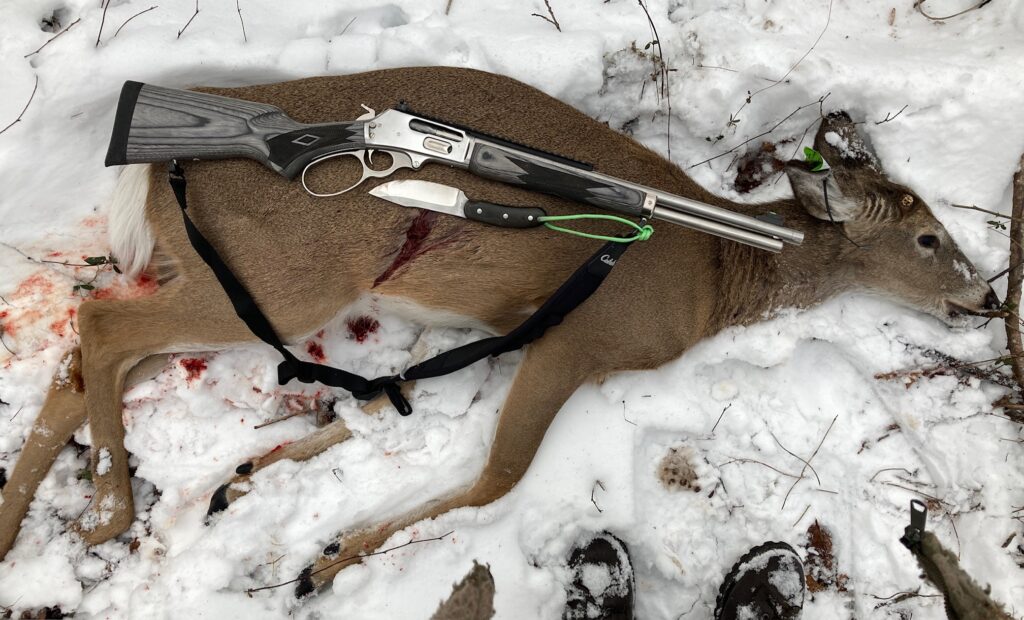
Deer I stalked and shot at 151 yards this week with the Marlin 1895 SBL. The 325-grain FTX bullet passed through lungs and stomach without slowing. Custom knife by JRJ John Johnson.
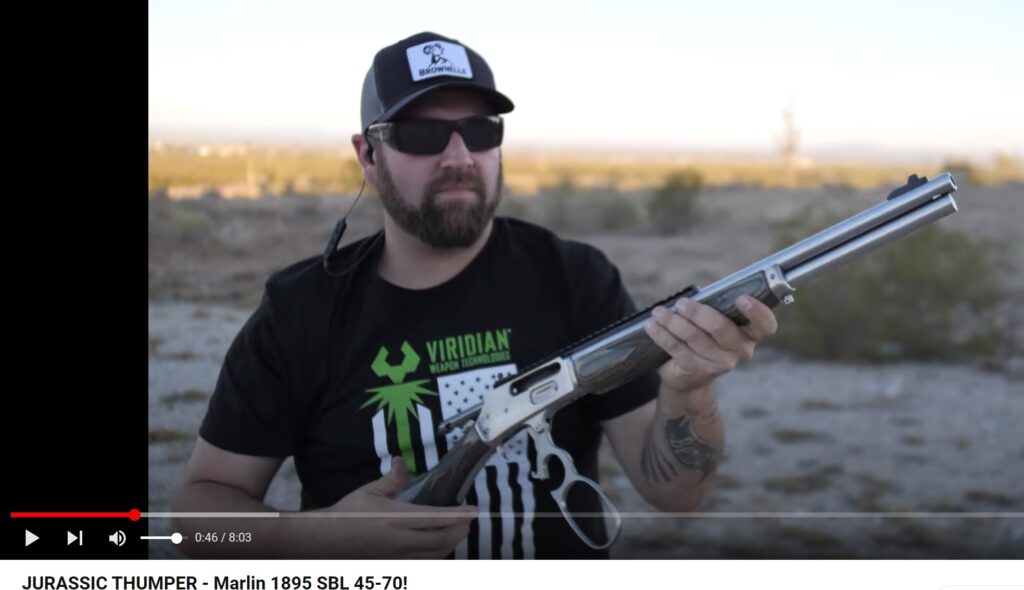
Exhibit A in macho gun reviews. Joe Cool shades in the shade. Biceps. Etc. Unfortunately, this rifle will not make his or your you-know-what bigger.

A 45-70 dangerous game round I loaded, using the 325-grain solid brass bullet by Cutting Edge Bullets. This is for stopping a grizzly
Some wonderful people gone
Jokes abound about aging, and quite a few are about those friends and family members who do not age with us, but who leave us all as we continue our own trajectory. Well, I am now definitely in the “aging” category and I am increasingly surrounded by people I enjoy and love who suddenly depart from this life. Recently two people here in Pennsylvania have left us all, and moved on to the spirit world, who I would like to mention. And it’s no joke, this dying thing. No matter what age a person is when they depart this life for the next, there is nothing funny about it.
Except maybe the last day on earth of European-Mexican artist Frida Kahlo, whose wild and often debauched Marxist Bohemian lifestyle made for intriguing movies and books. While some or maybe even a lot of the facts of Frida’s life may be funny depending upon the person considering them, her actual physical departure from this planet really is funny. I think.
After Frida died relatively young from cancer, or whatever it is that eventually afflicts the heavily debauched, her friends had her corpse dressed beautifully in her most customary colorful and flamboyant way, and prepared themselves all for a formal cremation send-off party in whatever crematory was present in Mexico City at the time. Her friends gathered in the crematory room while Frida’s corpse was ceremoniously loaded into the burn chamber, and as the roaring natural gas flames came to life, they all raised their glasses and toasted Frida.
And then the room erupted in gasps, cries, and people running for the exits, because suddenly Frida’s corpse stiffly bent at the waist, sat up, and made a wicked grin as her abundant hair caught on fire and created a demonic flaming halo around her yet untouched face. She wasn’t actually gone!
Yes, this was all her body’s muscular reaction to the sudden burst of 2,000-degree heat enveloping it, but apparently if you knew Frida, you kind of didn’t expect her to just die, you know, lie still and never move again. And indeed, she had lived up to all the hype about her, even while lying quite dead in the cremation chamber. I think this true story is funny, even though I did not know Frida and was not present at her cremation.
What is not funny and yet is not unexpected is the recent departure of Jim Brett, of Lenhartsville, PA, which for our geographically challenged readers is just north of I-78 and just south of Blue Mountain in Berks County, PA. Still confused where Lenhartsville, PA, is? OK, yes, it is the equivalent of East Succotash, PA, Nowheresville, PA, etc., and it is just about next to Hawk Mountain, the internationally famous sanctuary devoted to conserving birds of prey, especially on their annual migration south. There, solved this location question for you.
Hawk Mountain started as a simple land purchase to keep the shotgunners from standing on Blue Mountain’s highest Tuscarora sandstone boulder ridgetop and mindlessly swatting down out of the sky nearly every raptor that flew by on its way to South America. And in short order, more land purchases were added to what is now called the Kittatinny Ridge migration corridor. Hawk Mountain eventually became an educational organization and a destination for birders.
In the 1930s, birds of prey (hawks, owls, eagles, kites, vultures) were considered pestilential nuisances to farmers’ chickens and the rabbits and pheasants hunters enjoyed pursuing. In time, around the 1930s, raptors gradually became understood by some Americans as an important part of a healthy and properly functioning ecosystem, just as balanced populations of wolves, bears, mountain lions, bobcats and fishers have been subsequently understood today.
Hawk Mountain is now the world’s oldest continuously functioning conservation organization, but from 1934 to 1966 it was kind of a hidden gem, a hole in the wall of Blue Mountain that only certain initiates knew about or appreciated. It became much better known and more widely appreciated and much visited after Jim Brett became its second “curator,” as the chief executive position there is uniquely called.
As its leader, Jim Brett elevated Hawk Mountain to international status, built lots of buildings, hired lots of staff, attracted a lot of visitors, raised a lot of money, and he became a leading voice in bird conservation around our little blue and green planet.
On the outside, Jim Brett was a colorful Irishman, full of naughty jokes and a singular ability to imbibe liberally (often of his own make) and then hold forth to a captivated audience about biological and ecological science. But because Jim’s mother was Jewish, he had a separate interest in Israel, which, because it sits on a physical crossroads, is a lot like Blue Mountain. Israel is a birding Mecca.
A “sh*t ton” as Jim would say of raptors, storks, and other incredible and rare bird populations migrate through Israel, and Jim made their conservation from one end of their migration to the other one of his life’s missions. His Jewish half worked well with the Israelis, and his Irish half worked very well with the surrounding populations. One of his crowning achievements was working with Yossi Leshem to resolve bird strikes on Israeli fighter jets.
By finding ways to greatly reduce large rare birds being suddenly introduced to fighter jets at 1,000 mph, Yossi Leshem & Co. were able to save the lives of said rare birds, said giant titanium war eagles, and unsaid but implied young fighter pilots. It really was one of the great wild birds-living-with-modern-humans conservation success stories.
I met Jim Brett in 1998, when I had started working at PA DCNR in Harrisburg (having fled the corrupt and destructive US EPA in Washington DC). He was giving a presentation at an environmental and conservation education conference in Harrisburg, PA, and as the DCNR director of said polysyllabic educational field, it was my duty to both speak and to listen. Jim was standing up on the stage showing ancient stone tool artifacts and explaining the nexus between primitive hunter-gatherer lifestyles and the conservation or decimation of wildlife. I was hooked immediately.
Jim and I maintained a close personal and professional relationship until Fall, 2009, when I ran in a congressional primary (I was prompted to run by the devoutly corrupt and evil Manchurian Candidate Barack Hussein Obama, then president for nine months). My expressing my long quietly held political views educated not just Jim, but a sh*t ton of my “friends” and fellow conservationists alike about my true self. Gasp. Turned out that Jim did not know how conservative I was, and I did not know how liberal Jim was, and despite my desire to remain close, Jim had a hard time with it.
After 2009, our relationship involved less and less personal time, and fewer phone calls. I still have a generous gift that Jim gave me, which I occasionally take out and look at, admire, and then put it back in its safe place.
Jim and I stayed in touch through mutual friends for many years, including those who went on his African safaris he led. I can still recall Jim describing the funeral rite for a young son of a Maasai tribal leader, which he witnessed some time in the 1980s, I think: The boy’s body was ritually washed and then slathered in lamb fat, then put in the chieftain’s hut. The entire village was then evacuated and moved to an entirely new location, where a new settlement would be constructed. After the hyenas had entered the old village and consumed the boy’s body, the entire place was torched and left to become natural ecosystem thereafter.
Jim’s bright blue eyes flashed as he told this story, as indeed one would expect from someone so in tune with the endless hidden vibrations of our magical natural world. Though I know his spirit is now soaring with the majestic raptors, I doubt Jim’s liver will ever go the way of the hyena, Frida, or any mortal flesh for that matter. His official obituaries are here and here.
A second loss is someone I knew less closely, but with whom I shared a great deal in common and with whom I filled my buck tag this season: Phil Benner of Liberty, PA.
Until he unexpectedly died of Covid several days ago, the incredibly physically fit Phil Benner was a devoted father, a devoted husband, a devoted brother, a devoted uncle, a devoted son. He was a hard working small business owner, a risk-taking entrepreneur, and a pastor who saw God and felt Him deeply in the natural world around him, including the leaves rustling in the winter tree branches, and the quiet tinklebell sound of a small mountain stream’s clear waters falling over boulders. He appreciated everything and took nothing for granted.
Not only will I miss Phil Benner, the world will miss Phil Benner, because the world needs a billion more gentle, charitable, loving, devoted, kind, tolerant, peaceful Phil Benners. His loss is huge.
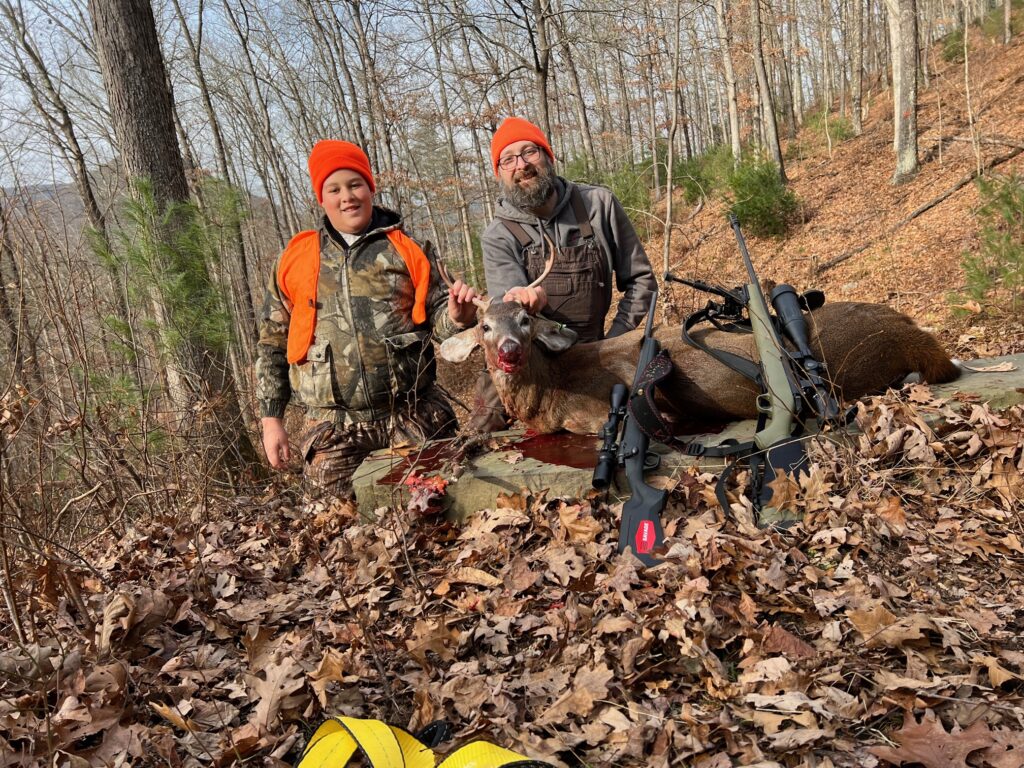
Phil Benner and his son Nate with a large bodied six point buck taken in Pine Creek Valley in late November, 2023
Book review: Secrets & Science of Primitive Archery
Ryan Gill’s book, The Secrets & Science of Primitive Archery, is a must-have for all stick bow hunters. You cannot find your way in the dark without a light, and this book is the illumination every traditional and self-bow hunter needs. I don’t care how long you have been hunting with your Osage orange self-bow or even a traditional bow by a small maker. If you hunt with something that does not have training wheels, then you need this book.
I must admit that I am almost ashamed it has taken me over a YEAR to review this book. Actually almost two years. Author Ryan Gill deserves much better treatment for all the hard work he put into this book. What can I say, Ryan. America has had a lot of ups and downs since 2021, and for political watchers and commenters like me, practically every day has felt like an all-hands-on-deck. All the political stuff has taken up the blog space. I am sorry, buddy. Hopefully I finally give you and the excellent book your due here.
As a traditional archery hunter since I was about fourteen, I have been enamored of bows made of a simple stick and a string. When us kids made our own bows out of saplings we cut in our woods (fifty years ago…), we would tie on a piece of baling twine and shoot arrows made of tree branches, goldenrod, whatever we could get our hands on, and practice with what we had. As the years went past, some of us were gifted compound bows, and others got simple recurves. I got a recurve, and some pretty sorry secondhand Easton aluminum arrows, to which I attached basic Bear broadheads.
If I had a nickel for every deer I collected hair from, I would have enough to buy a malted milkshake at the Lewisburg Freeze, which was fifty cents way back when, and costs five bucks now. That is to say, I never killed a deer with a bow, but missing didn’t stop me from trying.
Fast forward and I had my own kids, all of whom enjoyed shooting little fiberglass kid bows. When the boy attained the age of about seven, he demanded a “real bow,” and so off to the Eastern Traditional Archery Rendezvous we went. There we located a nice faux curly maple kid recurve with about 20 pounds of pull. Enough to skewer a squirrel or ball up a bunny in the back yard, which the boy kept after. Many years later we would go back to ETAR to get his real Big Boy bow, a reflex-deflex by the Kilted Bowyer. At 43 pounds pull weight at 26 inches, this is a true hunting machine, pretty, yes, but in all the clean simplicity a true bow should have.
But in between the little boy bows and the last big boy bow there were a lot of experiments over the years. Saplings cut, strings attached, arrows made, trials run. Like I did when I was a kid fascinated with the basic but powerful physics of archery. And this is where Ryan Gill’s fascinating book enters the picture.
Ryan Gill came to our attention by his YouTube videos. Because we were naturally looking for information about what we were doing right and doing wrong. Ryan doesn’t just cut saplings, attach a string, and shoot some crappy home made arrows. Au contraire! Ryan makes all kinds of powerful self-bows from all kinds of different woods, including Osage orange, hickory, black locust, and others, that will kill deer, bear, wild hogs, and even huge bison. And then Ryan strings the bows with real animal gut. And then he makes real cane arrows, tipped with real flint and chert heads that he himself knapped. Talking the real deal here. And through it all in his videos and his book, Ryan explains how primitive archery really worked tens of thousands of years ago, and how it can work really well for us today.
I learned a lot from this book.
Because I am a numbers guy, Ryan’s statistical analysis of his different bows, using different strings (animal and plant fiber), using different arrow shafts (river cane, wood) etc, really speaks to me. He does a great job of tabulating his data, which, when all his testing is said and done, tells us exactly where to go: Osage orange bow stave that is dried daily, using either a modern bow string or an animal gut string, and shooting properly made river cane shafts fletched with goose feathers and tipped with the proper and surprisingly small stone arrowhead, that go at least 130 feet per second, with 150 fps or better being the best and most likely to catch an unaware deer standing flat-footed.
If you are at all a traditional or aspiring primitive archery person, you need this book. This is a must-have resource that you will find nowhere else. It has an incredible amount of fascinating and directly applicable how-to information to every step and facet of primitive and traditional archery, as well as the historic and anthropological background to how primitive archery evolved. I read it twice before I felt qualified to write about it here, and I highly recommend it.
Welp…there is always the late deer season
The 2023 deer hunting season is probably going to be remembered in most parts of Pennsylvania as a strange time. For reasons already written about here previously, the deer just have not been available to the hunters in ways and numbers that hunters are accustomed to. On properties I hunt all over Central PA, deer were either invisible or invested with magical disappearing powers. Everywhere I am familiar with, the deer moved up hill, as far away from human activity as possible.
To say many hunters are frustrated is a big understatement.
All I can say to all this bad luck is that at least we have the upcoming late flintlock and archery seasons to try to make up for the low productivity of our regular season. And in at least one area designed to reduce Chronic Wasting Disease, DMAP 6396, we have a continuation of rifle season for antlerless deer only until late January. I intend to take a new rifle afield for that season in that area.
Folks, for the next ten days, practice, practice, practice with your flintlocks. My biggest challenge with flintlock hunting is the huge flash going off in my eyes. Once I get used to that, I am deadly steady with the old smoke pole. Probably takes me ten to twenty flashes to begin staying stone cold steady.
Late last year after a bunch of really lame close-range misses, I began practicing shooting my flintlock rifle with only priming powder in the pan, and nothing loaded in the barrel. Repeated trigger pulls with explosive flashes in my face helped me overcome my natural reaction of flinching and pulling my head back and away from the flame. Needs no explanation that moving your head off the gunstock is going to ruin your accuracy and aim, which means you probably won’t hit what you thought your gun was aimed at.
Ah yes, the well-earned moniker “flinchlock…”
Couple of recommendations: Go high up, because that is where most of the deer are, and try to hunt in groups, either as actual drives or as organized approaches to hunting the same area together.
Remember to go afield with a brand new sharp flint on your gun. If you take the old, dull flint that you have been practicing with this year, you stand a good chance of hearing “klunk” when you pull the trigger as the rounded flint then hits the frizzen without any sparks, and thus yields no primer ignition, and thus there is no ka-boom coming out the end of your gun barrel.
Though quite often the deer will be fascinated by the weird klunk sound, staying riveted in their spot staring intently in the direction of that odd sound. You might get a second or even a third trigger pull during this stare-down period.
Good luck, folks! Shoot straight and walk tall.
Do deer processors give you back your own deer?
Pennsylvania rifle season for deer is nearing the end of its second and concluding week. On average, Pennsylvania hunters annually kill 400,000-500,000 deer, and I would just hazard a guess that 2/3 of those carcasses are taken by the hunter to local deer processors.
Tonight, deer processors across Pennsylvania are working triple-staffed and double overtime to process the hundreds of thousands of deer being brought in by successful hunters.
A perennial question asked by both new hunters and well seasoned is “When I pick up my deer from the processor, will it actually be my deer I am getting, or will it be someone else’s deer?”
There are two certain answers to this question, and I base these on my own experience and the experiences of many friends and acquaintances.
First answer, Maybe. Depending on what you want done to your deer, you might get back 100% of your deer or you might get back 75% of your deer, with the 25% difference being parts of other people’s deer. If you just want real simple cuts, basic steaks from the backstraps and the hams, and roasts from the neck, leg, and shoulders, then you stand a better chance of getting your deer back. This is because it is almost as easy for the processor to cut your deer up into these basic cuts with a bandsaw and a boning knife as it is to grab whatever oddball cuts he has on hand to fill your order.
Second answer, when ordering sausage and hamburger, is absolutely No. This is because deer sausage, pepper sticks etc. are made from various trimmings and random pieces of deer as they are brought in from the very beginning of the archery season, based on the kind of demand that processor has experienced in the past. Additional batches of sausage are made as demand increases towards the end of archery season and into the rifle season. There is just no way that your deer can be turned into its own sausage mix. Your deer might be contributed to a big pot of deer trimmings destined for sausage, and you might be getting your portion of that sausage, but that sausage just isn’t going to be yours and yours alone. It will be a mix of various deer brought in the same time as your own.
I cannot tell you how many times I have gone through the expense of having my prize deer turned into beautiful shrink wrapped cuts at a processor, only to discover that the cardboard box I received my order in is short at least ten to fifteen pounds of venison (from a huge buck). And worse, some random pieces have been thrown in a try to make the balance, as the processor guesses it. And some of the packages have been frozen a long time. And the same cuts of meat are colored differently, as though from different animals.
The truth is that if you want to eat your deer, then you must either butcher your deer yourself, or get together with buddies and butcher all of your deer together.
Butchering a deer by yourself is much easier than most people think, especially if you are willing to cut up the backstrap and hams into basic steaks, and then grind up everything else for hamburger or sausage. In fact, I am about to take a deer I shot today over to a friend’s house where we are going to butcher it in his garage. This is going to be his first experience doing this, but I am sure it will not be his last time.
With buddies, you can pool your odd trimmings and leg meat for sausage. One or two guys or their wives run the sausage/ hamburger grinder and filler, and by the end of the weekend the sausage has been cooked/smoked, and everything is all done simultaneously. I have seen a historic hunting camp in Elk County that had the most impressive kitchen and butchery set-up, including scales for weighing both the whole deer and the various parts and cuts. This is nice so that the guy who shoots a 60-pound yearling gets his deer, and doesn’t unfairly get a bonus pay-out taken out of someone else’s 120 pound deer. Unless this is the way everyone agrees to work together: Everyone goes home with more or less the same amount.
Nothing against the deer processors, they have an important role to play. But the question asked in the beginning can only be satisfactorily answered by doing the job yourself, and I can say from long experience that butchering a deer is easy and gets faster and easier the more experienced at it you become.
Ok so how is your deer season going?
You wait all year for these two weeks of rifle season in PA, and then after a restless night the opening morning arrives. Five days in, and hardly a shot heard each day, no deer seen, hardly any sign encountered, and you are wondering what the heck is going on.
Don’t sweat it, you are not alone. You are in very good company. A lot of Pennsylvania hunters are grousing to each other tonight about not seeing any let alone many deer so far, not getting shots at deer, not even finding sign of deer, like poop or tree rubs. Not even hearing shots. Apparently Wisconsin is also seeing a real drop in their deer harvest in firearms season, too.
Something is amiss, especially in the Big Woods, no question.
Are we witnessing some mass die-off from disease, like Chronic Wasting Disease, or Epizootic Hemorrhagic Disease? It is possible, but I have not yet seen any deer skeletons lying randomly in the woods. Maybe they are out there and I just haven’t found the graveyard yet. In 2005 northcentral PA had a huge deer die-off from late season snow and ice that made the mountains impassible. The deer could neither walk on the surface for weeks, nor could they dig through the compacted ice and snow to reach food. We did encounter random deer carcasses everywhere during the spring that year.
Maybe black bears ate more deer fawns than we anticipated (I witnessed a large black bear catching, killing, and eating a young deer this May, which is cool). Same can be surmised for coyotes, which are renowned deer eaters. After several years of purposefully hard harvests, there are now fewer bears in PA, by design, and theoretically less bear depredation of fawns in 2023. But there does seem to be an awful lot of coyotes. Everywhere.
Up north, we have no acorns to speak of. Late spring frosts killed our acorn flowers a couple years in a row, and gypsy moths have been terrible year after year. Any acorn flowers that survived spring frosts were eaten by the gypsy moths, whose egg masses are visible everywhere up here. So there is very little to no food in the Big Woods, and as a result, most wild animals seem to have flown the coop. Bear hunting last week was impossible. And so far this week, deer hunting has been tough.
Yesterday I was fortunate to set up in a natural funnel and catch two does transitioning from feeding areas to bedding areas. And today, with the help of friends on a small and carefully targeted drive, I filled my buck tag. Based on what I am hearing, I am incredibly lucky this year. Most hunters are struggling just to see deer tails bouncing off into the distance.
So if you are one of the PA hunters who is feeling dispirited right now about the apparent evaporation of deer this season, here is my best advice: Go hunt places you don’t normally hunt, and where you think others probably don’t hunt often, either. Steep hillsides are great locations for hiding deer. Play the wind, keeping it in your face as much as possible. Go slow, and quiet. And have a friend or two join you for a two-man push or leap-frog, or a two-man push with one stander. And then the stander becomes a pusher and the former pushers take up stands.
Remember that whitetails like to loop around behind their pursuers. If one guy is pushing and another guy is quietly lagging behind a hundred yards or more, he has a good chance of getting the deer that snuck off and went around the pusher. Again, make sure the wind is in your favor (blowing from the deer to you, not from you to the deer), and be as quiet as possible.
Switch up your game this season, because it seems that just sitting and waiting for animals to come out and present themselves broadside is not happening a whole lot in 2023. We gotta get in after them, and make our own action.
Good luck!
Yeah, PA’s lame bear season in one picture
Pennsylvania is about to have one of its lowest bear harvests in decades. And like so many policies of any sort, the story of this failure is told not just by the data, but by a picture of the data (see below).
In sum, this year’s early bear seasons of archery and muzzleloader resulted in roughly 1200 bears being taken by hunters. These are predominantly individual hunters in elevated stands, not crews of drivers pushing bears to standers.
By the time the real firearms “bear season” arrives in late November, much of the steam has been bled out of the system, so to speak. The demand has been met. Many serious bear hunters have already taken their bear and they won’t be going “to camp” to participate in punishing bear drives through thick mountain laurel on steep mountains in the northcentral region. And when the most ardent hunters pull out of a camp, that loss of energy and excitement affects everyone else. We noticed many empty camps across the entire northern tier this past week.
Again, the 1,217 bears taken in the early season so far are 200 bears ahead of the roughly 1,000 bears on record for the “bear season” as of tonight, which is the end of the formal “bear season.” In other words, bear season wasn’t. It is actually producing behind the early season.
So is the early season the real bear season now?
Add a poor acorn crop to the situation, and whatever bears were roaming around in October’s early season have gone to den for the winter now in our “bear season,” or have moved southward by the time November arrives, because all of the available wild food has been eaten up. We are now in our third year of a failed acorn crop in the northern tier, and the silence of our woods shows it. No food means no wildlife. Hunters saw no poop, no deer rubs, no squirrels, no nothing. Hunters scouring rugged northern tier landscapes that are the historic high producers of bears are encountering woods devoid not just of bears, but of deer and turkey, as well.
Yesterday was a classic example of this dynamic. Our guys put on a drive across a NW Lycoming County mountaintop area that usually holds bears. I was the lone stander in the primo spot, a saddle between two hills with a stream running through. I could see far in every direction. There were no other drives happening anywhere around our guys, which is unusual. But another and much larger drive was going on behind me, and pushing toward the area we had hunted the day before. And half a mile down the forest road several long range hunters were set up looking across a canyon. If there were bears around, or even deer, the two drives would push them past the long range guys, at least.
And yet, by the time dusk arrived and our men had slid and tumbled down the mountain side to gather at the truck, no one anywhere had seen a bear or a deer, nor heard a shot. The long range guys were packing up as we were driving out, and they told us they had seen several deer on Sunday, but nothing else any other day, including that day that had so much activity.
The Pennsylvania Game Commission is a government agency, and agencies make mistakes. Sometimes the best-intended and carefully considered policies have unintended consequences. Maybe the Saturday opener (as opposed to the long-time Monday opener) to bear season is part of the failure we are seeing. Maybe it’s the acorn crop failure making a bad situation worse. Maybe it’s the early season stealing all of the thunder from the regular rifle bear season. I don’t know the entire answer why, but the numbers don’t lie, and this 2023 bear season was a flop. Yes, we will see another 100-200 bears taken in the extended season that is concurrent with deer season in some Wildlife Management Units. But overall, PA has not seen a bear harvest this low in a long time. And as I recall, last year wasn’t that great, either.
Something is wrong and something needs to change. A lot of small businesses in rural areas depend on these big bear and deer seasons to make their end-of-year financial goals. Let’s hope the PGC staff and the board are up to the task of fixing it.
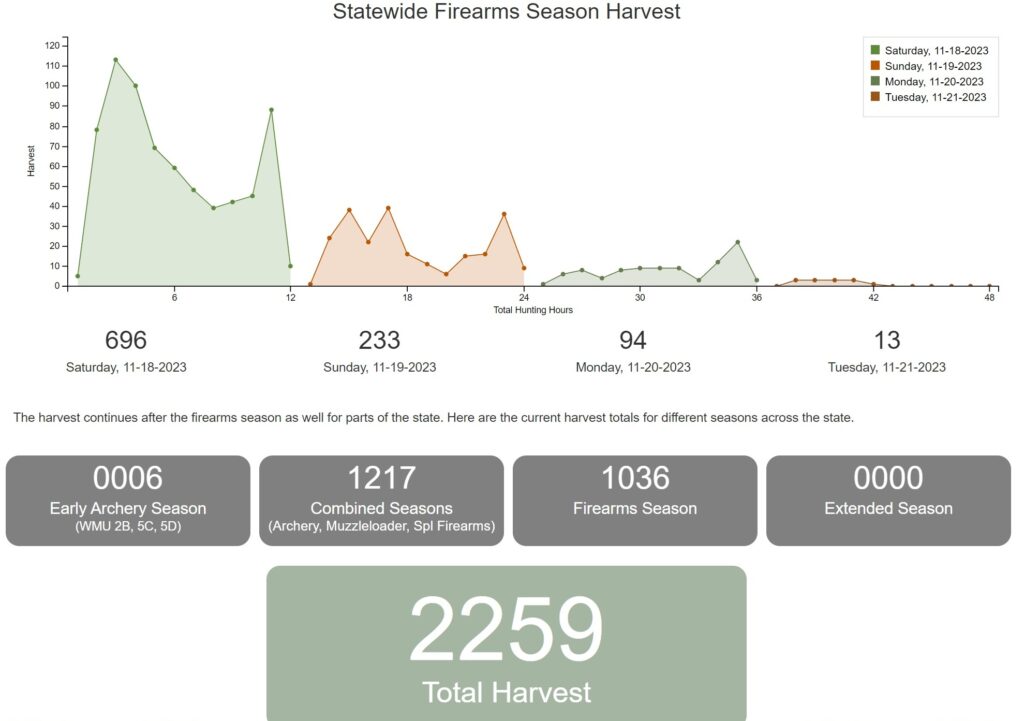
Harvest results as of the last night of regular rifle bear season, 2023. Not final, but not going to change much. The early season was the best season.
PA’s 2023 bear season
After hearing just one rifle shot all day (followed by the customary follow-up shot thirty seconds later, and the coup-de-grace shot a minute later) today, at 4:20PM, I felt compelled to write about what seems to be happening this bear season. In a nutshell, this is not your pap’s or even your dad’s Pennsylvania bear season in Northcentral PA. That long-hallowed experience of buffalo plaid Woolrich coats and moldy little hunting camps built in 1948 filled with men putting on big drives across the landscape, is now a thing of the past.
Some people blame the Saturday bear season opener that started eight years ago for the demise. Others blame the early October muzzleloader and archery seasons. Either way, what many hunters are calling the death of the famed PA bear season is actually a direct result of the incredible success of PA’s decades-long bear population conservation program.
When PGC biologist Gary Alt became the steward of the PA bear program in the early 1980s, he faced a problem. Hunters, nature lovers, and simple habitat and ecosystem health required more bears across Pennsylvania. And bears were not responding to the demand. In twenty years of hard and smart work, Dr. Alt turned the situation completely around. When Dr. Alt left the PGC twenty years ago, his life’s work was one of the great wildlife conservation success stories in America. Black bears then filled habitat niches in almost every county from Philadelphia to Erie, from Honesdale to Pittsburgh, and everywhere in between.
And then, almost overnight it seemed, PA had way too many bears. Bears were showing up in cities proper, turning over trash cans in suburban back yards everywhere. And so the PGC had to try and dial back some of Dr. Alt’s success. Increasing the number of bears taken by hunters was the solution.
Now looking at harvest data resulting from a half dozen years of early muzzleloader bear season, early archery season, regular bear season, and extended bear seasons running concurrent with deer season, it is easy to see why we only heard one rifle shot all day today in what probably still is the epicenter of PA’s bear hunting. And why none of our guys encountered any bears hanging from hunting camp porches on their valley run tonight.
Early muzzleloader and archery seasons combined now account for almost half of the overall annual PA bear harvest, even before “bear season” has begun. These early season hunters are mostly single men hunting near their homes. By the time the traditional bear season arrives in late November, half the licensed bear hunters who are likely to kill a bear are already tagged out, and the rest are looking forward to the concurrent bear-deer seasons in their home hunting territories. Few hunters feel compelled to make the historic annual migration north, and why would they?
Those of us, we hardy few, who do still come to the traditional bear hunting ground up north, are faced with an already depleted bear resource, and many fewer men pushing across the landscape to break free and push those bears that remain. And yet, despite our reduced opportunity, we enjoy the crisp Fall air, the camaraderie, the laughs, and the naughty food and drink our wives would never approve of, if they only knew.
Good luck this season, boys. You’re gonna need it.
